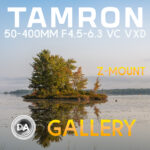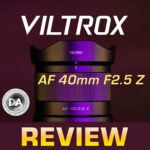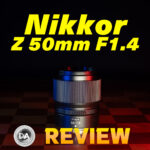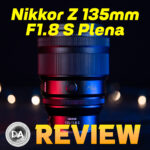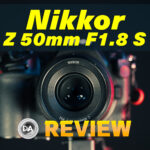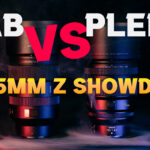
Tamron initially released the Tamron 70-300mm F4.5-6.3 Di III RXD back in 2020 (Tamron code A047) on Sony E-mount. I gave it a solid review, noting that it combined light weight, solid autofocus, and a very good optical performance at a excellent price of $549 USD. My chief complaints centered around having no lens-based stabilization (relying on in-camera stabilization if the camera was so equipped), weak corner performance on the wide end, and a lack of a zoom lock to prevent zoom creep while hiking or backpacking with it. At the time Canon’s RF mount and Nikon’s Z-mount were closed to third party development, meaning that that the 70-300mm was a Sony exclusive. While Canon has remained very stubborn about opening their full frame RF mount to third parties, Nikon has begun to loosen up their Z mount, which has allowed a number of important Tamron zooms to cross over to Nikon. The 70-300mm F4.5-6.3 RXD was the first of these. And while this is the same basic lens, the 70-300 Z (as we’ll refer to it in this review), this is the superior version of the lens to have for a few Nikon-specific reasons. The price has increased a bit in the transition to Nikon (MSRP rose from $549 to $699, though it is currently discounted to $599 at the time of this review), but this is still a bargain at that price. Find out why in my video review below or by reading on.
Follow Me @ YouTube | Patreon | Instagram | Facebook | DA Merchandise | Flickr | 500px | X
__________________________________________________________________________________________________
Thanks to Tamron US for sending me a review copy of this lens. As always, this is a completely independent review. All opinions and conclusions are my own. *The tests and most of the photos that I share as a part of my review cycle have been done with the 45MP Nikon Z8, which I reviewed here.
__________________________________________________________________________________________________
Here are a few of the key features of the 70-300 Z:
- Z-Mount Lens/Full-Frame Format
- Weather sealed USB-C port
- Low Dispersion Front Element
- BBAR Broad-Brand Anti-Reflection Coating
- RXD Stepping AF Motor
- Moisture-Resistant Construction
- Rounded 7-Blade Diaphragm

I noted that there are some key Nikon specific improvements. Only one of these is a physical change, but it is a positive one. More recent Tamron lenses have typically included a weather sealed USB-C port that allow the lens to be connected to a computer or Android device and for one to use Tamron’s free Lens Utility Software to do firmware updates and to make a variety of tweaks to the lens behavior. Now in this case the functionality is limited to just firmware updates as the lens isn’t really designed with any customizable aspects, but I do find that this is a very quick and clean way to do firmware updates.

But more substantial improvements come in the different way that Nikon cameras function and what artificial limitations are imposed. On Sony there is a broad restriction on maximum burst speed for any non-Sony lens, namely that the maximum burst rate achievable with a third party lens like this Tamron mount will be capped at 15FPS. I own Sony’s Alpha 1, which is capable of achieving 30FPS, which means that I can only get half of the maximum burst rate with a Tamron mounted. This just isn’t the case on Nikon, and so I can shoot at the full 30FPS achievable of my Z8 and with excellent autofocus throughout. The 70-300 Z felt like a much more capable sports lens mounted on my Z8:

The second improvement is related to camera based stabilization (IBIS, or In Body Image Stabilization). In 2020 I used a Sony a7RIII and a9 as my test cameras, and while the IBIS was rated at 5.5 stops in the a7RIII, the real world performance rarely came anywhere near that number. It was notably weaker when shooting with telephoto lenses, so I found that I did miss having lens-based stabilization in the 70-300mm. On paper the IBIS in the Z8 is only a little better (6 rated stops of stabilization), but in real world practice the difference was much more extreme. In practice the stabilization at 300mm on the Sony cameras was more like 2-2.5 stops, while on the Z8 I was easily able to get repeatable results at 300mm, 1/8th of a second, which is more than 5 stops of assistance. Getting 6 stops certainly seems feasible.

Now, to be fair, my newer Sony cameras today are capable of better results than those older cameras, but I still find that the VR feels more solid with these unstabilized telephoto lenses on Nikon than what I find on Sony. In fact, I was more successful in shooting this handheld test on my Z8 with the unstabilized 70-300 Z than I was in shooting with the brand new Tamron 50-300mm VC (which does have stabilization) on my Sony a7RV (which, in theory, is rated for up to 8 stops of assistance).

Bottom line: the 70-300mm definitely performs better on Nikon Z than it did on Sony E. But that does raise a key argument: what about that new Tamron 50-300mm VC? (which I reviewed here) It is a much improved lens, but once again it initially arrives as a Sony exclusive. I have some confidence that it will make its way to Z-mount (where I would be very interested in getting one), but that does create some cloud over whether one should buy the 70-300Z for now. The 50-300mm on Sony has come at a $250 price premium, so the 70-300mm will undoubtedly continue to be the value option.
Build and Handling
Tamron’s early philosophy on their Di III (mirrorless) designs was banking on the proposition that people are more interested in strong performance at a value price than they are on features that they may or may not use. Tamron’s focus on performance (both optical and autofocus) has allowed their zoom lenses to be very strong optically relative to the competition even while offering considerably less in the features department. This has changed in their newer designs, which have become more feature rich, but the 70-300 Z harkens from that earlier design philosophy. The design language is simple and uncluttered, but it is also very bare – no switches or even a zoom lock – just the narrow manual focus ring and then the larger, more thickly ribbed zoom ring.

The design of that manual focus ring leaves a bit to be desired. It is flush mounted and thus doesn’t fall to hand as easily. Because its edge is flush with the lens barrel, it isn’t easy to do single finger adjustments due to some of the finger’s pressure going to the lens barrel rather than the ring. I also find that the damping isn’t amazing, and while it is possible to focus with precision (and manual focus is great on the Z8!), the feel isn’t nearly as nice as some other lenses.

The Z-mount version of this lens has grown a bit to accommodate both the larger diameter of the Z-mount as compared to Sony’s E-mount and also to deal with the difference in the flange distance from the sensor to the beginning of the lens elements required for proper focus. The Z-mount version is heavier (580g, or 20.5oz) vs 545g (19.2oz) for the Sony E-mount version. The 70-300 Z is also a bit longer (150.3mm or 5.9″) vs 148mm for the E-mount version. The diameter stays the same (77mm or 3″), as while the lens is wider at the lens mount, that isn’t the widest portion of the lens. Tamron retains the 67mm front filter thread that is shared across the vast majority of their mirrorless lenses, making filter sharing very easy.
The Tamron 70-300 Z is a bit larger and heavier, yes, but not enough to meaningfully change anything. I actually found the lens more comfortable to use on Nikon due to having more knuckle room between the Z8’s grip and the lens barrel.

This is definitely lighter than most all competing lenses in this class. Tamron does note, “Taking the weight savings even further, we used a specially treated, high-strength aluminum-magnesium alloy, the first time Tamron has used this material in the mount components of a lens for full-frame mirrorless cameras. The new design maintains excellent strength while successfully reducing weight to around 68% of previous mounts.” So, to be fair, the weight savings wasn’t just achieved by cutting features.
This is an externally zooming design, and when you twist the large zoom ring the lens barrel will extend about 59mm additionally. Here’s the retracted length:

…along with the fully extended length:

The zoom action is fairly smooth, though there’s a bit of a “pump” action at points where it feels like air is being pushed. I don’t love that sensation, as it feels like there is a risk of dust being brought into the lens. Tamron has counteracted that possibility with a nice degree of weather sealing, including a gasket at the lens mount along with internal seals at the rings and front element. Special coatings on the front element help resist fingerprints and moisture.


I’ve never owned this lens or used it long term, so I can’t attest to how well the lens resists dust over the long haul. I will note that I’ve never received complaints about dust intrusion from my YouTube audience, so I suspect it isn’t a problem.
There are no switches on the barrel, so you’ll have to choose between AF/MF and (potentially) control the IBIS (if your camera has it) from within the camera. Also missing is a zoom lock that will keep the lens locked in the retracted position and keep it from inadvertently zooming. I definitely found while hiking that the A047 would end up zoomed after a bit either from from friction or gravity. Not a big deal, per se, but I do prefer to having the locking option. The only feature outside of the ring on the lens barrel is the USB-C port (which is weather sealed to prevent water intrusion much like what is found on most modern cell phones).

The Tamron 70-300 Z fills a definite hole in the Nikon Z lineup. This focal range in covered in part by some 70-180 or 70-200mm F2.8 zooms, but those cost 2-4x as much, and by by the 100-400mm F4.5-5.6 VR S lens, though that lens costs more than 4x as much. The Tamron 70-300 Z ably helps fill the spot that Tamron and Sigma are best suited to – high performing mid-tier lenses that are much more affordable.
Also worth noting is that this lens is not compatible with any teleconverters, though that is pretty typical for this class of lens. They are too small to leave room for teleconverters to physically mount at the rear.

A fairly deep lens hood is included, and this (along with internal BBAR coatings), helps with flare resistance.
The build itself is nothing fancy, but it does feel fairly tough and the zooms from this series that I’ve personally owned for years have held up well with no evidence of wear or dysfunction.
This is a variable aperture zoom, going from F4.5 on the wide end to F6.3 on the telephoto end. The lens moves through apertures like this:
- 70-112mm – F4.5
- 113-154mm – F5
- 155-241mm – F5.6
- 242-300mm – F6.3
This is a fairly strong performance, and is one area that the newer 50-300mm VC lens has actually regressed in.
As has become common with these Tamron zooms, there are two different minimum focus distances. At 70mm, you can focus as closely as 0.8m (31.5 in) or 1.5m (59.1 in) on the telephoto end. At 70mm, the maximum magnification is only about 0.11x (1:9.4), and looks like this:

At 300mm, the magnification figure increases to right under 0.20x (1:5.1), which looks like this:

The latter figure is more obviously useful, and that, combined with the compression from the longer focal length, allows for nicely blurred backgrounds and good detail.

So this is a fairly simple lens, and it is in the feature section that some of these Tamron zooms come up short, but fortunately better news lies ahead…
Autofocus and Video
The 70-300 Z is equipped with Tamron’s RXD (Rapid eXtra-silent stepping Drive) focus system (yes, Tamron was very randomly selective with what letter they chose to highlight!) This high-speed stepping motor has been smooth, powerful, and quiet in each of the applications I’ve seen it in. Tamron has moved to their VXD linear focus motor in newer, more expensive lenses, but that doesn’t stop this lens from performing well here. Focus is very fast, very quiet, and very smooth. The only time I’ve saw focus slow down is in very poor light on the telephoto end (F6.3 doesn’t allow as much light to reach the sensor as, say, an F2.8 zoom, which is part of the reason why zooms like that are valuable for event work).

I’m quite new to Nikon and its autofocus system, but I intentionally chose the Z8 because of its (deserved) reputation for great autofocus. I’ve been very pleasantly surprised by how well the 70-300 Z focuses on my Z8. Even during fast action (and a low shutter speed), I could both get motion blur of the bats while also getting clear focus of the batter’s faces during a softball game.



I got good eye detect performance while out capturing wildlife, from turkeys:

…to deer and birds.



Focus is nice and quiet, and speed is very good, though not quite as instantaneous as Tamron’s VXD-equipped lenses. Focus accuracy was excellent, whether it be with a human subject:

…or with an animal subject.

On the video front, focus pulls were fast and mostly confident, though I did see an occasional micro-pulse in there. Video footage stood out as being very crisp and detailed, and focus breathing wasn’t too bad.
My hand test (where I alternately use my hand to block the camera’s view of my face and then remove it didn’t go great, but largely because I think the camera is pretty determined to stay locked on my face despite the distraction of the hand. It simply ignored my hand and stayed locked on my face beyond.
Still, all things considered, this is a pretty strong autofocus performance. A $600 telephoto that can keep up with action at 30FPS is pretty great, so I see nothing to complain about here.
Tamron 70-300 Z Image Quality Breakdown
Optical performance has been a place where the Tamron zooms for Sony have really shined, often competing with (and even besting) much more expensive first party options. Does that trend continue here? First of all, a quick look at the MTF performance and optical specifications:

This is obviously the same lens optically as what I tested on Sony, but I went ahead and retested on the 45MP Nikon Z to assure that my past findings remain true on this new system. The MTF chart suggests a very sharp lens in the center of the frame, but with a much more consistent performance at 300mm than at 70mm. We’ll explore that in a moment, but first, a look at vignette and distortion at 70mm:

As with the Sony version, there is basically no distortion at 70mm. Unlike the Sony version, however, is that vignette is heavier here on Nikon. I needed a +74 to correct it and noticed that with my chart tests that I need to increase the vignette correction on the standard profile (originally set up for Sony) to accommodate the roughly one additional stop of vignette.
In the middle of the zoom range the distortion pattern changes to a pincushion style distortion.

I used a -8 to correct the distortion. It is nice and linear and corrected well. Vignette has reduced, requiring just a +44 to correct for it.
At 300mm the pattern remains the same, though with slightly less distortion.

I used a -6 to correct the distortion, but the vignette has gotten much heavier, requiring a whopping +90 to correct for.
Vignette is definitely more pronounced on Nikon than on Sony. One can tell the optical design was Sony first at least in this regard.
Longitudinal chromatic aberrations come in the form of color fringing before and after the plane of focus, but we can see that they are extremely well controlled on this lens.

Real world results also showed minimal amounts of fringing.

There are also minimal amounts of fringing near the edges of the frame when stopped down.

So let’s turn out attention to resolution and contrast. These results are from a 45MP Nikon Z8 and crops at shown at approximately 200% to exaggerate strengths and weaknesses. Here’s the test chart:

And here are 70mm, F4.5 crops from across the frame:



We see exactly what the MTF suggests: a great center performance, good mid-frame results, and soft corners.
And those corners never really sharpen up at 70mm. By F8 they are improved, but still pretty soft.

The same is true for real world results. This 70mm shot at F8 is nice and crisp in the center and mid-frame, but you can see that the corners look pretty soft.



This is one of the areas that are improved on the new 50-300mm lens.
Moving on to 100mm shows an interesting quirk on Nikon. The Z8 shows a little more precision in terms of the aperture value, so we can see that the effective aperture has closed a bit to F4.8 (not yet F5). Sharpness is improved all across the frame at 100mm. You can particularly see that along the edges of the frame, which are obviously sharper than at 70mm.

You’ll see more gains to sharpness and contrast at F5.6 and F8. Corners are sharpest at F8, though sharpness still isn’t as exceptional there as it is elsewhere in the frame.

Minimum aperture varies depending on the starting maximum aperture, running from F22 on the wide end to F32 on the telephoto end. You will want to avoid the minimum aperture due to diffraction reducing contrast and detail. You can see a pretty remarkable difference between F11 and F25 here:

Image quality remains excellent at 135mm, with the corners looking better than any previous focal length.

200mm is also nice and consistent. It isn’t quite as sharp in the center, but is better everywhere else. Corners are looking better than ever, and the rule of thirds area of the frame is nice and sharp.

Real world shots in this range look nice and sharp.

300mm is much like 200mm, though perhaps a percentage point or two less sharp. As the MTF suggests, the center isn’t quite as sharp as the wide end, but the sharpness profile is much more consistent across the frame. It is pretty much good everywhere.



This translates into nicely detailed results even at F6.3:


As you can see from the shot above, you can create very nice bokeh when you are shooting on the telephoto end and are relatively close to your subject.
But images look pretty good even when I’m a bit further away from the subject. You can see in this shot of a resting duck that both the bokeh and detail look good at 300mm, F6.3:


You can see that even with a slightly busier background the overall look of the image here is very nice.

Tamron’s BBAR coatings do a good job with flare resistance. I saw relatively little ghosting or veiling with the lens pointed towards the sun.

All in all this is a good optical result. Corner sharpness isn’t very good on the wider end, and there’s a bit more vignette here on Nikon, but outside of that we’ve got a lens capable of producing very nice images in a wide variety of circumstances.
Conclusion
This is my first review of a Tamron lens in a Z-mount, and it has been a satisfying experience. It’s nice to see a familiar lens grow in function and value due to there not being artificial limits imposed upon it. The Tamron 70-300mm F4.5-6.3 RXD is a bit more expensive on Nikon Z, but the additional performance is well worth the small price premium.

Autofocus seems to have made the transition to Z mount extremely well, with good speed, accuracy, and confidence. I’m also really enjoying the better stability for the lens that I’ve found on my Z8 versus on Sony bodies.

The truth of the matter is there are few direct competitors for this lens on Z-mount, so it really fits a need. It provides a quality telephoto option on a budget. No, there isn’t much here in terms of features, but if your goal is just to take nice pictures with good autofocus (and have some weather sealing on your lens), then this 70-300 Z checks a lot of boxes for the budget price of $600 USD.

Yes, there is a new and improved 50-300mm VC on the horizon, but there is no guarantee as to how soon we’ll see that lens on Z mount, particularly considering that none of the 2023 Tamron releases have made it to Z-mount yet. In the meantime, this is a perfectly capable lens that was generally fun to use during my review period and provided me a number of photos I was very happy with.
Pros:
- Fits a real need in the Z mount lineup
- Addition of USB-C port for firmware updates
- Weather sealing
- Light weight
- No artificial limit on burst speed
- Autofocus kept up with action
- Good focus precision and speed
- Very sharp center and mid-frame throughout zoom range
- Good control of aberrations
- Good flare resistance
- Nice bokeh
- Great price-to-performance ratio
Cons:
- Soft corners at 70mm
- VC would be nice for non-stabilized cameras
- No zoom lock
- Increased vignette on Z mount
_________________________________________________________________________
GEAR USED:
Purchase the Tamron 70-300mm RXD @ B&H Photo | Adorama | Amazon | Camera Canada | Amazon Canada | Amazon UK | Amazon Germany
_______________________________________________________________
Purchase the Nikon Z8 @ B&H Photo | Adorama | Amazon | Camera Canada | Amazon Canada | Amazon UK | Amazon Germany
_________________________________________________________________
Want to support this channel? Use these affiliate links to shop at: B&H Photo | Amazon | Adorama | Camera Canada | Amazon Canada | Amazon UK | Ebay | Make a donation via Paypal
Buy DA Merchandise https://bit.ly/TWIMerch

Keywords: #withmytamron, Tamron 70-300mm, RXD, Di III, F4.5-6.3, Tamron 70-300 Z Review, Nikon, Nikon Z8, Z, Z-mount, Z8, Review, mirrorless, Full Frame, Sports, Tracking, Dustin Abbott, Real World, Comparison, Handling, Focus, Portraits, Resolution, High ISO, Image Quality, Sample Images, Photography, 45MP, #letthelightin, #DA, #NIKON, #Z8, #NIKONZ8



